动词第三人称单数构成规则
- 格式:ppt
- 大小:179.00 KB
- 文档页数:2
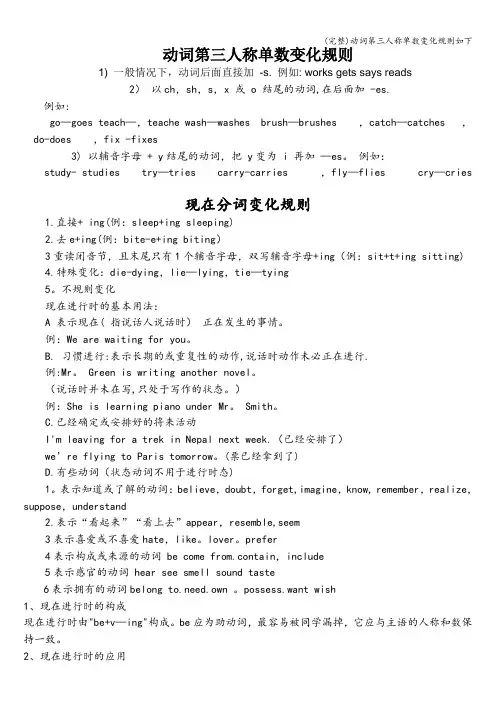
动词第三人称单数变化规则1) 一般情况下,动词后面直接加-s. 例如: works gets says reads2)以ch,sh,s,x 或 o 结尾的动词,在后面加 -es.例如:go—goes teach—,teache wash—washes brush—brushes ,catch—catches ,do-does ,fix -fixes3) 以辅音字母 + y结尾的动词,把 y变为 i 再加—es。
例如:study- studies try—tries carry-carries ,fly—flies cry—cries现在分词变化规则1.直接+ ing(例:sleep+ing sleeping)2.去e+ing(例:bite-e+ing biting)3重读闭音节,且末尾只有1个辅音字母,双写辅音字母+ing(例:sit+t+ing sitting)4.特殊变化:die-dying,lie—lying,tie—tying5。
不规则变化现在进行时的基本用法:A 表示现在( 指说话人说话时)正在发生的事情。
例:We are waiting for you。
B. 习惯进行:表示长期的或重复性的动作,说话时动作未必正在进行.例:Mr。
Green is writing another novel。
(说话时并未在写,只处于写作的状态。
)例:She is learning piano under Mr。
Smith。
C.已经确定或安排好的将来活动I'm leaving for a trek in Nepal next week.(已经安排了)we’re flying to Paris tomorrow。
(票已经拿到了)D.有些动词(状态动词不用于进行时态)1。
表示知道或了解的动词:believe,doubt,forget,imagine,know, remember,realize,suppose,understand2.表示“看起来”“看上去”appear,resemble,seem3表示喜爱或不喜爱hate,like。
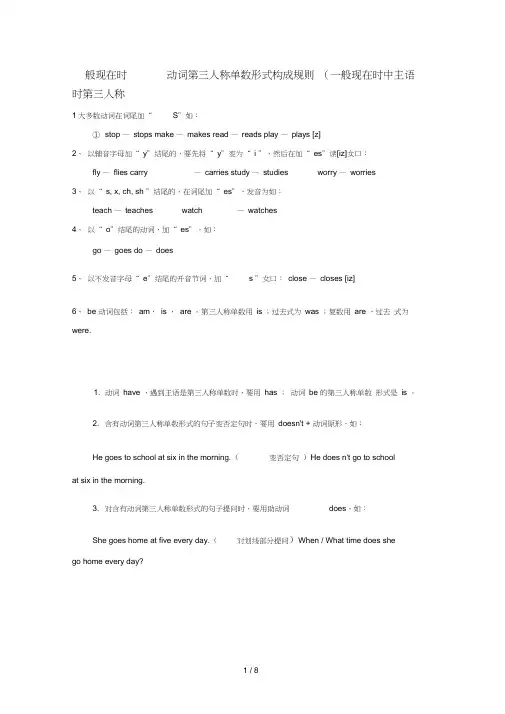
般现在时动词第三人称单数形式构成规则(一般现在时中主语时第三人称1大多数动词在词尾加“S”如:①stop —stops make —makes read —reads play —plays [z]2、以辅音字母加“ y”结尾的,要先将“ y”变为“ i ”,然后在加“ es”读[iz]女口:fly —flies carry —carries study —studies worry —worries3、以“ s, x, ch, sh ”结尾的,在词尾加“ es”,发音为如:teach —teaches watch —watches4、以“ o”结尾的动词,加“ es”,如:go —goes do —does5、以不发音字母“ e”结尾的开音节词,加“s ”女口:close —closes [iz]6、be 动词包括:am,is ,are 。
第三人称单数用is ;过去式为was ;复数用are ,过去式为were.1. 动词have ,遇到主语是第三人称单数时,要用has ;动词be 的第三人称单数形式是is 。
2. 含有动词第三人称单数形式的句子变否定句时,要用doesn't + 动词原形,如:He goes to school at six in the morning.(变否定句)He does n't go to schoolat six in the morning.3. 对含有动词第三人称单数形式的句子提问时,要用助动词does,如:She goes home at five every day.(对划线部分提问)When / What time does shego home every day?般现在时中的第三人称单数形式在一般现在时中,当主语是第三人称单数时,谓语动词要用第三人称单数形式,原形后加即常在动词-s 或-es 。
I 什么是一般现在时?一般现在时的基本用法有哪些呢?No. 1 】一般现在时的功能1. 表示事物或人物的特征、状态。
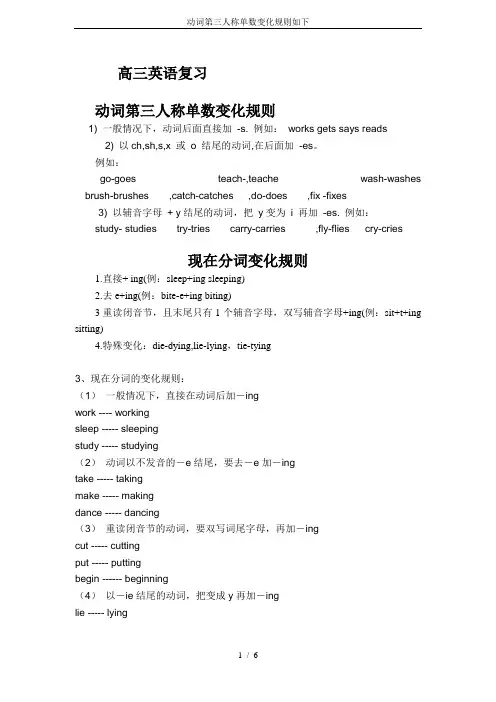
高三英语复习动词第三人称单数变化规则1) 一般情况下,动词后面直接加-s. 例如:works gets says reads2) 以ch,sh,s,x 或o 结尾的动词,在后面加-es。
例如:go-goes teach-,teache wash-washes brush-brushes ,catch-catches ,do-does ,fix -fixes3) 以辅音字母+ y结尾的动词,把y变为i 再加-es. 例如:study- studies try-tries carry-carries ,fly-flies cry-cries现在分词变化规则1.直接+ ing(例:sleep+ing sleeping)2.去e+ing(例:bite-e+ing biting)3重读闭音节,且末尾只有1个辅音字母,双写辅音字母+ing(例:sit+t+ing sitting)4.特殊变化:die-dying,lie-lying,tie-tying3、现在分词的变化规则:(1)一般情况下,直接在动词后加-ingwork ---- workingsleep ----- sleepingstudy ----- studying(2)动词以不发音的-e结尾,要去-e加-ingtake ----- takingmake ----- makingdance ----- dancing(3)重读闭音节的动词,要双写词尾字母,再加-ingcut ----- cuttingput ----- puttingbegin ------ beginning(4)以-ie结尾的动词,把变成y再加-inglie ----- lyingtie ----- tyingdie ----- dying① 一般单音节词末尾加er 和est② 单音节词如果以e结尾,只加r 和st③ 闭音节单音节词如末尾只有一个辅音字母,须先双写这个辅音字母,再加er和est ④ 少数以y,er(或ure),ow,ble 结尾的双音节词,末尾加er和est(以y结尾的词,如y前是辅音字母,把y变成i,再加er和est,以e结尾的词仍加r和st)late later latest3. big bigger biggesthot hotter hottestthin thinner thinnest4. easy easier easiestbusy busier busiesthappy happier happiest5. valuable more valuable most valuabledangerous more dangerous most dangerouscomfortable more comfortable most comfortable1. 有几个形容词有特殊的比较级和最高级形式:原级比较级最高级good well better bestbad ill worse worstmany much more mostlittle less least far farther further farthest furthestold older elder oldest eldest2. 双音节词除了以“辅音+y”结尾的词外,还有以ow, er, le结尾的词,和个别其他双音节词,可以用加词尾的办法构成比较级和最高级:原级比较级最高级narrow narrower narrowestclever cleverer cleverestsimple simpler simplestcommon commoner commonest3. 也有少数单音节词可以加more和most的办法构成比较级和最高级:原级比较级最高级pleased more pleased most pleasedtired more tired most tiredglad more glad most glad名词的复数形式其它名词复数的规则变化1) 以y结尾的专有名词,或元音字母+y 结尾的名词变复数时,直接加s变复数:如:two Marys the Henrysmonkey---monkeys holiday---holidays比较:层楼:storey ---storeys story---stories2) 以o 结尾的名词,变复数时:a. 加s,如:photo---photos piano---pianosradio---radios zoo---zoos;b. 加es,如:potato--potatoes tomato--tomatoesc. 均可,如:zero---zeros / zeroes3) 以f或fe 结尾的名词变复数时:a. 加s,如:belief---beliefs roof---roofssafe---safes gulf---gulfs;b. 去f,fe 加ves,如:half---halvesknife---knives leaf---leaves wolf---wolveswife---wives life---lives thief---thieves;c. 均可,如:handkerchief:handkerchiefs / handkerchieves动词变名词1.在词尾加er,r ,双写加er 或or:A. play _ player, sing _ singer, wait _ waiter , find _ finder,thrill _ thriller,hunt-hunterB. write _ writer, drive _ driver, come _ comer, explore _ explorerdance _ dancerC. run _ runner, win _ winner, rob _ robber, traval _ travallerD. visit _ visitor, invent _ inventor,act-actor,advise-advisor2. 在词尾加ing:build _ building, draw _ drawing, end _ ending, begin _ beginning,swim _ swimming,skate _ skating, feel _ feeling, say _ saying,mean _ meaning, cross _ crossing,surf _ surfing, paint _ painting3.在词尾加ion 或去e加ion:A. decide _ decision, describe _ description, produce _ production, celebrate _ celebration,pronounce _ pronunciation, decorate _ decoration graduate _ graduation,frustrate - frustration,pollute _ pollutioncontribute _ contribution, congratulate _ congratulation,educate _ education,organize _ orgnization,donate _ donation, appreciate _ appreciation,operate _ operation, invite _ invitationB. discuss _ discussion, invent _ invention, attract _ attractionimpress _ impression,inject _ injection,instruct _ instruction4.其它:know _ knowledge, please _ pleasure, enjoy _ enjoyment,practise _ practice,die _ death, succeed _ success, weigh _ weight,sit _ deat, change _ chance,enter _ entrance,fly _ flight,rob _ robbery, discover _ discovery,faile _ failure,appear _ appearance, breathe _ breath。
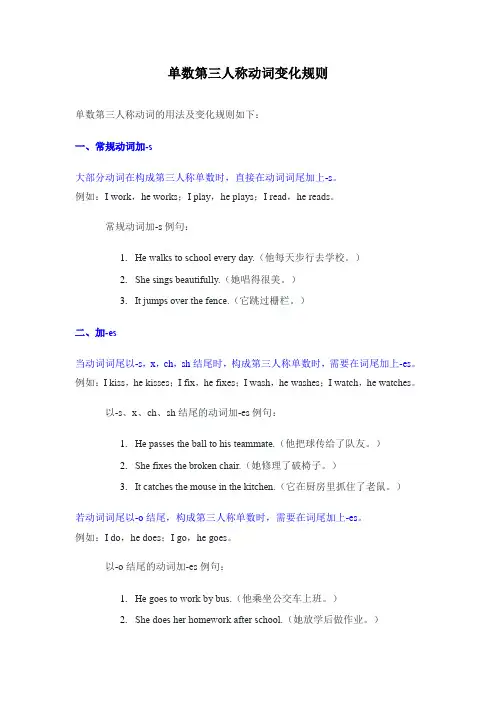
单数第三人称动词变化规则单数第三人称动词的用法及变化规则如下:一、常规动词加-s大部分动词在构成第三人称单数时,直接在动词词尾加上-s。
例如:I work,he works;I play,he plays;I read,he reads。
常规动词加-s例句:1.He walks to school every day.(他每天步行去学校。
)2.She sings beautifully.(她唱得很美。
)3.It jumps over the fence.(它跳过栅栏。
)二、加-es当动词词尾以-s,x,ch,sh结尾时,构成第三人称单数时,需要在词尾加上-es。
例如:I kiss,he kisses;I fix,he fixes;I wash,he washes;I watch,he watches。
以-s、x、ch、sh结尾的动词加-es例句:1.He passes the ball to his teammate.(他把球传给了队友。
)2.She fixes the broken chair.(她修理了破椅子。
)3.It catches the mouse in the kitchen.(它在厨房里抓住了老鼠。
)若动词词尾以-o结尾,构成第三人称单数时,需要在词尾加上-es。
例如:I do,he does;I go,he goes。
以-o结尾的动词加-es例句:1.He goes to work by bus.(他乘坐公交车上班。
)2.She does her homework after school.(她放学后做作业。
)3.It echoes through the canyon.(它在峡谷中回荡。
)三、先将y改变为i,再加上-es。
当动词词尾为以辅音字母+y结尾时,构成第三人称单数时,需要先将y改变为i,再加上-es。
例如:I fly,he flies;I try,he tries;I study,he studies;I carry,he carries。
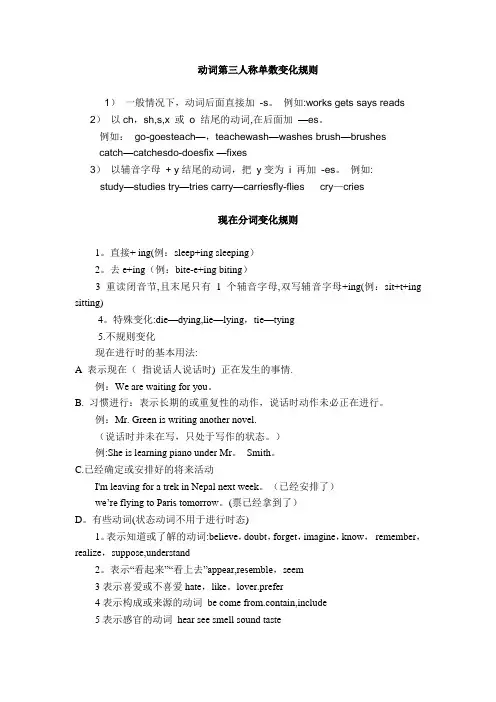
动词第三人称单数变化规则1)一般情况下,动词后面直接加-s。
例如:works gets says reads 2)以ch,sh,s,x 或o 结尾的动词,在后面加—es。
例如: go-goesteach—,teachewash—washes brush—brushescatch—catchesdo-doesfix —fixes3)以辅音字母+ y结尾的动词,把y变为i 再加-es。
例如:study—studies try—tries carry—carriesfly-flies cry—cries现在分词变化规则1。
直接+ ing(例:sleep+ing sleeping)2。
去e+ing(例:bite-e+ing biting)3重读闭音节,且末尾只有1个辅音字母,双写辅音字母+ing(例:sit+t+ing sitting)4。
特殊变化:die—dying,lie—lying,tie—tying5.不规则变化现在进行时的基本用法:A 表示现在(指说话人说话时) 正在发生的事情.例:We are waiting for you。
B. 习惯进行:表示长期的或重复性的动作,说话时动作未必正在进行。
例:Mr. Green is writing another novel.(说话时并未在写,只处于写作的状态。
)例:She is learning piano under Mr。
Smith。
C.已经确定或安排好的将来活动I'm leaving for a trek in Nepal next week。
(已经安排了)we’re flying to Paris tomorrow。
(票已经拿到了)D。
有些动词(状态动词不用于进行时态)1。
表示知道或了解的动词:believe,doubt,forget,imagine,know,remember,realize,suppose,understand2。
表示“看起来”“看上去”appear,resemble,seem3表示喜爱或不喜爱hate,like。
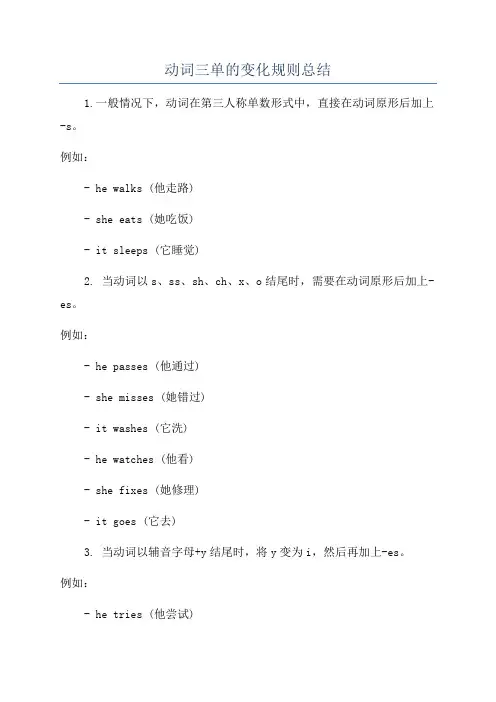
动词三单的变化规则总结
1.一般情况下,动词在第三人称单数形式中,直接在动词原形后加上-s。
例如:
- he walks (他走路)
- she eats (她吃饭)
- it sleeps (它睡觉)
2. 当动词以s、ss、sh、ch、x、o结尾时,需要在动词原形后加上-es。
例如:
- he passes (他通过)
- she misses (她错过)
- it washes (它洗)
- he watches (他看)
- she fixes (她修理)
- it goes (它去)
3. 当动词以辅音字母+y结尾时,将y变为i,然后再加上-es。
例如:
- he tries (他尝试)
- she carries (她携带)
- it studies (它学习)
4.当动词以元音字母+y结尾时,直接在动词原形后加上-s。
例如:
- he plays (他玩)
- she says (她说)
5. 当动词以辅音字母+o结尾时,需要在动词原形后加上-es。
例如:
- he goes (他去)
- she does (她做)
6. 当动词以辅音字母+o结尾且在末尾之前有一个辅音字母时,需要在动词原形后加上-es。
例如:
- he goes (他走)
- she echoes (她回响)
需要注意的是,以上的规则只适用于大多数动词,但也有一些特殊情况需要记住,比如不规则动词的变化形式。
此外,有些动词在第三人称单数形式中没有变化,即与动词原形相同,比如:she likes (她喜欢)。
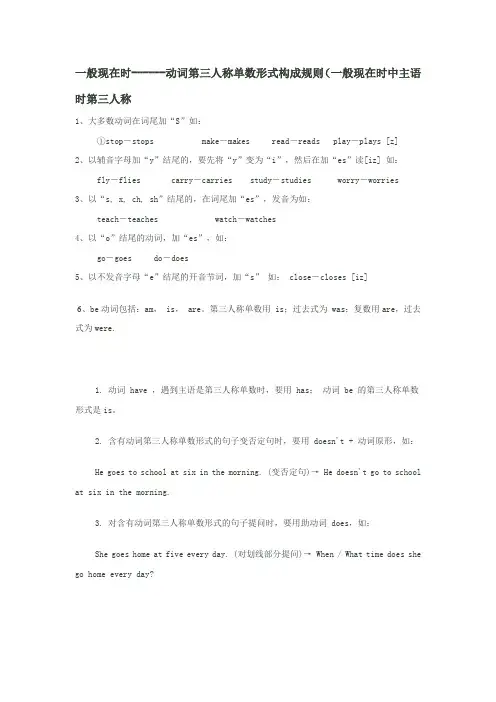
一般现在时------动词第三人称单数形式构成规则(一般现在时中主语时第三人称1、大多数动词在词尾加“S”如:①stop-stops make-makes read-reads play-plays [z]2、以辅音字母加“y”结尾的,要先将“y”变为“i”,然后在加“es”读[iz] 如:fly-flies carry-carries study-studies worry-worries3、以“s, x, ch, sh”结尾的,在词尾加“es”,发音为如:teach-teaches watch-watches4、以“o”结尾的动词,加“es”,如:go-goes do-does5、以不发音字母“e”结尾的开音节词,加“s”如: close-closes [iz]6、be动词包括:am, is, are。
第三人称单数用 is;过去式为 was;复数用are,过去式为were.1. 动词 have ,遇到主语是第三人称单数时,要用 has;动词 be 的第三人称单数形式是is。
2. 含有动词第三人称单数形式的句子变否定句时,要用 doesn't + 动词原形,如:He goes to school at six in the morning. (变否定句)→ He doesn't go to school at six in the morning.3. 对含有动词第三人称单数形式的句子提问时,要用助动词 does,如:She goes home at five every day. (对划线部分提问)→ When / What time does she go home every day?一般现在时中的第三人称单数形式在一般现在时中,当主语是第三人称单数时,谓语动词要用第三人称单数形式,即常在动词原形后加-s或-es。
I 什么是一般现在时?一般现在时的基本用法有哪些呢?【No. 1】一般现在时的功能1.表示事物或人物的特征、状态。
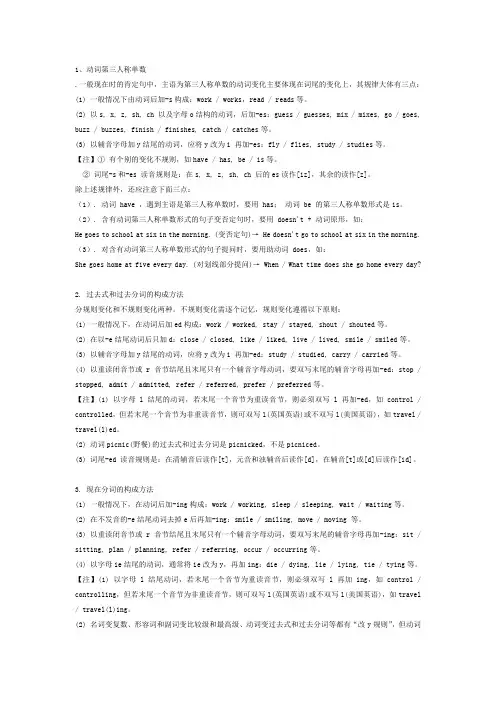
1、动词第三人称单数.一般现在时的肯定句中,主语为第三人称单数的动词变化主要体现在词尾的变化上,其规律大体有三点:(1) 一般情况下由动词后加-s构成:work / works,read / reads等。
(2) 以s, x, z, sh, ch 以及字母o结构的动词,后加-es:guess / guesses, mix / mixes, go / goes, buzz / buzzes, finish / finishes, catch / catches等。
(3) 以辅音字母加y结尾的动词,应将y改为i 再加-es:fly / flies, study / studies等。
【注】①有个别的变化不规则,如have / has, be / is等。
②词尾-s和-es 读音规则是:在s, x, z, sh, ch 后的es读作[iz],其余的读作[z]。
除上述规律外,还应注意下面三点:(1). 动词 have ,遇到主语是第三人称单数时,要用 has;动词 be 的第三人称单数形式是is。
(2). 含有动词第三人称单数形式的句子变否定句时,要用 doesn't + 动词原形,如:He goes to school at six in the morning. (变否定句)→ He doesn't go to school at six in the morning. (3). 对含有动词第三人称单数形式的句子提问时,要用助动词 does,如:She goes home at five every day. (对划线部分提问)→ When / What time does she go home every day?2. 过去式和过去分词的构成方法分规则变化和不规则变化两种。
不规则变化需逐个记忆,规则变化遵循以下原则:(1) 一般情况下,在动词后加ed构成:work / worked, stay / stayed, shout / shouted等。
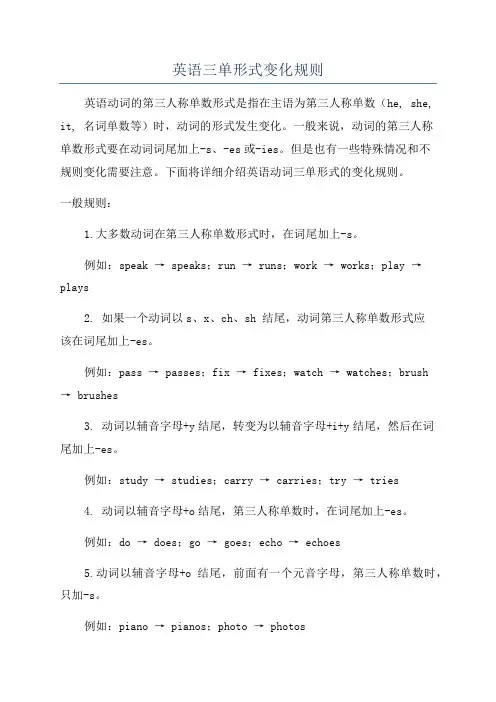
英语三单形式变化规则英语动词的第三人称单数形式是指在主语为第三人称单数(he, she, it, 名词单数等)时,动词的形式发生变化。
一般来说,动词的第三人称单数形式要在动词词尾加上-s、-es或-ies。
但是也有一些特殊情况和不规则变化需要注意。
下面将详细介绍英语动词三单形式的变化规则。
一般规则:1.大多数动词在第三人称单数形式时,在词尾加上-s。
例如:speak → speaks;run → runs;work → works;play → plays2. 如果一个动词以s、x、ch、sh 结尾,动词第三人称单数形式应该在词尾加上-es。
例如:pass → passes;fix → fixes;watch → watches;brush→ brushes3. 动词以辅音字母+y结尾,转变为以辅音字母+i+y结尾,然后在词尾加上-es。
例如:study → studies;carry → carries;try → tries4. 动词以辅音字母+o结尾,第三人称单数时,在词尾加上-es。
例如:do → does;go → goes;echo → echoes5.动词以辅音字母+o结尾,前面有一个元音字母,第三人称单数时,只加-s。
例如:piano → pianos;photo → photos6. 动词以辅音字母+consonant字母+ y 结尾,将y改为ies。
例如:study → studies;fly → flies;cry → cries7.动词以“辅音字母+_y”的形式结尾,但是该辅音字母前是一个元音字母。
这种情况下,动词的第三人称单数形式在词尾加上-s。
例如:play → plays;pray → prays;enjoy → enjoys不规则变化:除了一般的规则以外,还有一些常见的动词变化形式是不规则的,需要单独记忆。
1. be → is(am,are)例如:She is a student. → He is a teacher.注意:be动词变化形式较为特殊,主语为第三人称单数时,is是be 动词的正确形式。
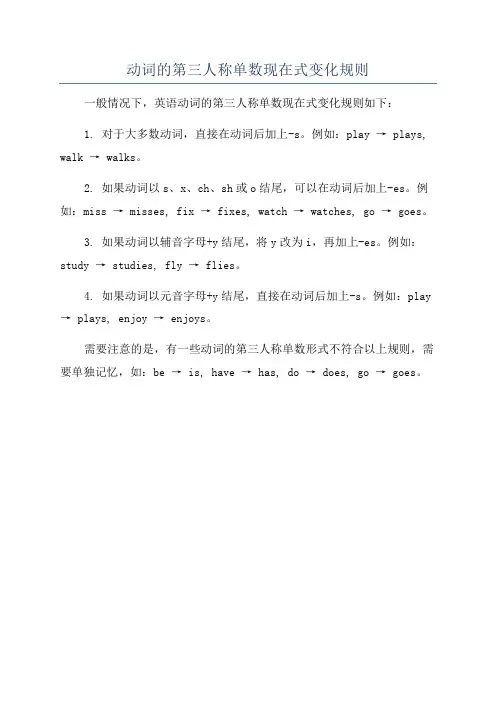
动词的第三人称单数现在式变化规则一般情况下,英语动词的第三人称单数现在式变化规则如下:
1. 对于大多数动词,直接在动词后加上-s。
例如:play → plays, walk → walks。
2. 如果动词以s、x、ch、sh或o结尾,可以在动词后加上-es。
例如:miss → misses, fix → fixes, watch → watches, go → goes。
3. 如果动词以辅音字母+y结尾,将y改为i,再加上-es。
例如:study → studies, fly → flies。
4. 如果动词以元音字母+y结尾,直接在动词后加上-s。
例如:play → plays, enjoy → enjoys。
需要注意的是,有一些动词的第三人称单数形式不符合以上规则,需要单独记忆,如:be → is, have → has, do → does, go → goes。
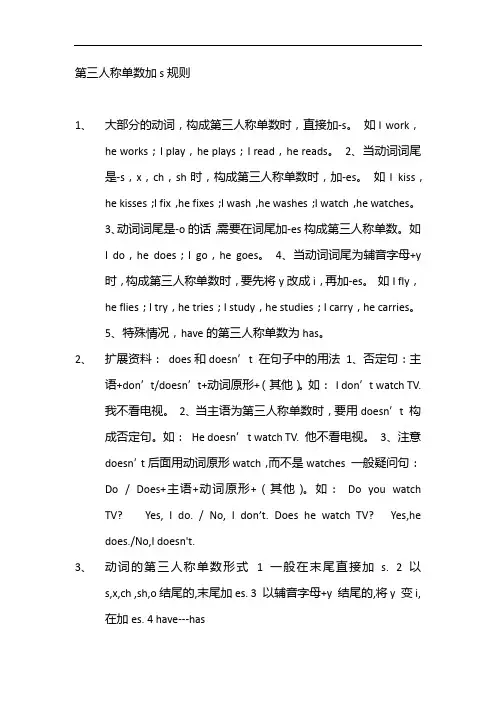
第三人称单数加s规则1、大部分的动词,构成第三人称单数时,直接加-s。
如I work,he works;I play,he plays;I read,he reads。
2、当动词词尾是-s,x,ch,sh时,构成第三人称单数时,加-es。
如I kiss,he kisses;I fix,he fixes;I wash,he washes;I watch,he watches。
3、动词词尾是-o的话,需要在词尾加-es构成第三人称单数。
如I do,he does;I go,he goes。
4、当动词词尾为辅音字母+y时,构成第三人称单数时,要先将y改成i,再加-es。
如I fly,he flies;I try,he tries;I study,he studies;I carry,he carries。
5、特殊情况,have的第三人称单数为has。
2、扩展资料:does和doesn’t 在句子中的用法1、否定句:主语+don’t/doesn’t+动词原形+(其他)。
如:I don’t watch TV.我不看电视。
2、当主语为第三人称单数时,要用doesn’t 构成否定句。
如:He doesn’t watch TV. 他不看电视。
3、注意doesn’t后面用动词原形watch,而不是watches 一般疑问句:Do / Does+主语+动词原形+(其他)。
如:Do you watch TV? Yes, I do. / No, I don’t. Does he watch TV? Yes,he does./No,I doesn't.3、动词的第三人称单数形式 1 一般在末尾直接加s. 2 以s,x,ch ,sh,o结尾的,末尾加es. 3 以辅音字母+y 结尾的,将y 变i,在加es. 4 have---has4、第三人称单数后,大部分动词直接加s。
三单的动词的具体变化形式:1、一般直接加s:如plays;2、以sh、ch、s、x、o 结尾的动词加es,如:watches,does,fixes等;3、辅音字母加y结尾的,变y为i加es,如studies;4、特殊的,如:have 变成has,be变成is。
英语动词第三人称单数变化规则一般现在时的肯定句中,主语为第三人称单数的动词变化主要体现在词尾的变化上,其规律为:1、变否定句:含有动词第三人称单数形式的句子变否定句时,要在动词前面加上doesn’t 或does not,动词的第三人称单数形式要还原成原形:格式为doesn’t/does not + 动词原形,如:He goes to school at six in the morning. (变否定句)→He doesn't go to school at six in the morning.2、变一般疑问句:把含有动词第三人称单数形式的变成一般疑问句时,要借用助动词does,如:She goes home at five every day.→Does she go home at five every day?--- Yes, she does./No, she doesn’t.哪些主语是第三人称单数?1、人称代词he, she, it;如:He likes watching TV. 他喜欢看电视。
She has lunch at twelve. 她十二点吃午餐。
It looks like a cat. 它看起来像只猫。
2、单个人名、地名或称呼作主语;是第三人称单数。
如:Han Mei looks like her mother. xx看起来像她的母亲。
is in . xx在xx。
Uncle Wang often makes cakes. xx叔叔经常做蛋糕。
3、单数可数名词或this / that / the + 单数可数名词作主语时,是第三人称单数;A horse is a useful animal. 马是有用的动物。
This book is yours. 这本书是你的。
That car is red. 那辆小汽车是红色的。
The cat is Lucy's. 只猫是露xx的。
动词第三人称单数变化规律
动词的第三人称单数变化规律是在一般现在时态中,对于大多数动词,在主语是第三人称单数时,动词要加上-s或-es结尾。
具体的规律如下:
1. 对于以辅音字母+y结尾的动词,将y改为i,再加上-es。
例如:study →studies,fly →flies。
2. 对于以“s, sh, ch, x”等音结尾的动词,直接加上-es。
例如:pass →passes,watch →watches。
3. 对于以-o结尾的动词,大多数情况下直接加上-es。
例如:go →goes,do →does。
但也有一些例外,如:go →goes,do →does。
4. 对于以辅音字母+o结尾的动词,要先双写该辅音字母,再加上-es。
例如:go →goes,do →does。
5. 对于以辅音字母+consonant结尾的动词,要先双写该辅音字母,再加上-es。
例如:stop →stops,run →runs。
6. 对于以f或fe结尾的动词,通常要将f或fe变为v,再加上-es。
例如:leaf →leaves,give →gives。
需要注意的是,这只是一般规律,也有一些特殊的动词不遵循以上规则,需要具体根据单词的构成和规则来判断变化形式。
一般现在时------动词第三人称单数形式构成规则(一般现在时中主语时第三人称1、大多数动词在词尾加“S”如:①stop-stops make-makes read-reads play-plays [z]2、以辅音字母加“y”结尾的,要先将“y”变为“i”,然后在加“es”读[iz] 如:fly-flies carry-carries study-studies worry-worries3、以“s, x, ch, sh”结尾的,在词尾加“es”,发音为如:teach-teaches watch-watches4、以“o”结尾的动词,加“es”,如:go-goes do-does5、以不发音字母“e”结尾的开音节词,加“s”如: close-closes [iz]6、be动词包括:am, is, are。
第三人称单数用 is;过去式为 was;复数用are,过去式为were.1. 动词 have ,遇到主语是第三人称单数时,要用 has;动词 be 的第三人称单数形式是is。
2. 含有动词第三人称单数形式的句子变否定句时,要用 doesn't + 动词原形,如:He goes to school at six in the morning. (变否定句)→ He doesn't go to schoolat six in the morning.3. 对含有动词第三人称单数形式的句子提问时,要用助动词 does,如:She goes home at five every day. (对划线部分提问)→ When / What time does she go home every day?一般现在时中的第三人称单数形式在一般现在时中,当主语是第三人称单数时,谓语动词要用第三人称单数形式,即常在动词原形后加-s或-es。
I 什么是一般现在时?一般现在时的基本用法有哪些呢?【No. 1】一般现在时的功能1.表示事物或人物的特征、状态。
动词单三变化规则口诀
一般来说,英语动词的单数第三人称变化规则有以下几种口诀:
1.一般情况下,动词加s就搞定。
例如:talk -> talks, walk -> walks
2. 含有s, sh, ch, x, o结尾的动词,变为单数第三人称时加es。
例如:pass -> passes, kiss -> kisses
3. 以辅音字母+y结尾的动词,去y加ies。
例如:carry -> carries, fly -> flies
4.以元音字母+y结尾的动词,直接加s。
例如:play -> plays, say -> says
5. 以辅音字母+o结尾的动词,加es。
例如:do -> does, go -> goes
注意:还有一些特殊不规则的动词单数第三人称变化,无特定规则可循,需要记忆:
例如:have -> has, go -> goes
希望以上规则能帮到您。
动词第三人称单数变化规则如下高三英语复习动词第三人称单数规则一)一般情况下,动词后面直接加-s.例如:worksgetssaysreads2)以ch、SH、s、x或O结尾的动词,后跟-es。
例如:go goesteach-,teache洗brush-brushes,catch-catches,do-does,fix-fixes3)以辅音字母+y结尾的动词,把y变为i再加-es.例如:study-studiestry-triescarry-carries,fly-fliescry-cries现在分词变化规律1.直接+ing(例:sleep+ingsleeping)2.去e+ing(例:bite-e+ingbiting)3.重读封闭音节,结尾只有一个辅音,并双写辅音+ing(例如sit+T+ingsitting)4.特殊变化:die-dying,lie-lying,tie-tying3.现在分词的变化规则:(1)一般情况下,直接在动词后加-ingwork----workingsleep-----sleepingstudy-----studying(2)这个动词以一个清音的-E结尾。
转到-E并加上-ingtake------take make------make------dancing(3)重读闭音节的动词,要双写词尾字母,再加-ingcut-----cuttingput-----puttingbegin------beginning(4)以-ie结尾的动词改为y并加上-inglie----liengtie-----tyingdie-----dying3.也有一些单音节词可以添加更多和最多,以形成比较级和最高级:最初的比较级和最高级更清晰,最近更新gladmoregladmostglad名词的复数形式构成方法在词尾加-s1.以s、x、sh、ch结尾的名词后加-es2.如词尾是e,只加-s如词尾为cf或cfe,则一般变为cves以辅音+y结尾的名词,变y为i再加-es以元音+y结尾的名词,加-s以辅音+o结尾的名词,加-es以元音+o结尾的名词,加-s以-th结尾的名词,加-s例词英语里有一些名词的复数形式不是以词尾-s或-es构成,构成方法变内部元音foot[u]―feet[i:]man[]―men[e]mouse[au]―mice[ai]woman[]―women[e]词尾加-enox―oxen(公牛)child[ai]―children[i]形式不变(通形名词----单、复数同形)deer―deerfish―fishsheep―sheep集合名词(只有复数,没有单数。
小学英语动词第三人称单数变化规则一般现在时的肯定句中,主语为第三人称单数的动词变化主要体现在词尾的变化上,其规律为:1、变否定句:格式为doesn’t/does not + 动词原形,如:He goes to school at six in the morning. (变否定句)→He doesn't go to school at six in the morning.2、变一般疑问句:要借用助动词does,如:She goes home at five every day.→Does she go home at five every day?--- Yes, she does./No, she doesn’t.哪些主语是第三人称单数?除I、you之外的所有可数名词单数及不可数名词。
(he she it 个人名)例题引路:判断下列词语哪些是第三人称单数,是请打“√”不是请打“×”。
he ( ) we( ) she( ) they( )it ( ) Han Mei ( ) uncle Wang ( )the farmers( ) my mother( ) Linda( )Sally and Lucy( ) the dog( ) the cats( )1、写出下列动词的第三人称单数。
drink ________ go _______ stay ________ make ________ look _________ have_______ pass_______ carry _______ come________ watch________ plant_______ fly ________ study_______ brush________ teach________ 2、用括号内动词的适当形式填空。
1. He often ________(have) dinner at home.2. We _____________ (not watch) TV on Monday.3. Nick ___________ (not go) to the zoo on Sunday.4. ________ they __________ (like) the World Cup?5. What _________they often _________ (do) on Saturdays?6. _________ your parents _________ (read) newspapers every day?7. There ________(be) some water in the bottle.8. My aunt _______(look) after her baby carefully.9. The child often _______(watch) TV in the evening.10. Mike’s sister ________ (cook) nice food. I _______ (like) eating it very much. 21. _______ (do) your brother_______ (watch) TV in the evening? No, he_______ (not).3、选出正确的答案:1. She (like / likes) to play football.2. He (like / likes) drinking milk.3. I (like / likes) to watch TV.4. We (like / likes) to play badminton.5. They (like / likes) to sing songs.6. She (read / reads) books every day.7. He (play / plays) computer games every day.8. It (listen / listens) to the radio every day.9. Linda (draw / draws) pictures every day.10. Jane and Linda (play / plays) football every day.5、把下列句子变为否定句:1. We like playing football.2. Linda swims every day.3. They like playing games.4. My father reads newspaper in the evening.7、把下列句子变为疑问句,并做肯定和否定回答。